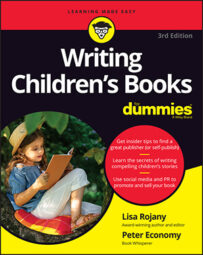Sometimes there is something wrong with your children's book manuscript, and you simply can’t identify what it is. When you’re editing your work, you need to know not only how to recognize the problem, but also what to do to fix it.
Strengthen your opening
You need a strong opening sentence. This may sound like a no-brainer, but it’s really quite important. To hook your reader right away, your opening lines should contain some suggestion of conflict, apprehension, suspense, or at least a promise of such.
Tricks for creating good opening lines include starting off with a bit of dialogue or a conversation, piquing the reader’s curiosity with a glimpse into some very dramatic event, then pulling away before its conclusion to set the mood of the story, or describing the main character and her problem in one short sentence:
Now Kathryn Camille had a big, fat problem, and if she didn’t solve it by eight o’clock that night she was dead meat.
With a chapter book, you can spend an entire paragraph setting a scene. In a picture book, you have to jump into the action ASAP. Don’t worry if it takes a while for a strong opening sentence to come to you. Many writers leave that task until the very end.
Keep your dialogue tight and on target
Are your characters’ personalities reflected in their speech pattern, tone, or the content of their dialogue — or do you have a five-year-old character who speaks like a teenager or a mad scientist who has trouble articulating even basic scientific concepts?
Dialogue that doesn’t match the characters as you’ve drawn them makes your writing seem implausible and confusing, or wooden and lifeless.
Go through all your dialogue and make sure each character sounds appropriate for his age and what he’s in your story to accomplish plot wise. Also check that the characters sound different from one another.
Another issue is excessive use of dialogue. Dialogue is a great way to get information across to your reader through an interesting source: the character. But a character (just like a real person) who just blabs on and on can be boring. Don’t write a character you wouldn’t want to spend any time with in real life.
Characters who talk to themselves or spend too much time wondering aloud are not effective characters. Dialogue must involve interaction that moves the plot forward in a meaningful, measurable way.
Transition effectively
In a book you must help the reader move from scene to scene, from place to place, from character to character. How do you do that? Simple! You use transitions effectively.
Transitions are passages that connect one bit to another. They move you forward in time without getting you lost and are necessary when your character changes locations, activities, conversations, or time frames, or when your story alters its focus. They can be as brief as one word or as long as a sentence.
Here’s a trick: Use one word from the last sentence of a paragraph in an obvious way in the first sentence of the next paragraph to indicate change while promoting continuity.
When you have managed to put together all the little pieces into the coherent whole that make for a great story, check that all your transitions are present, accounted for, and effective.
Trim wordiness
Many would-be writers think that because children’s books are short, they must be really easy to write. It’s actually more difficult to write shorter works. When you have a limited word count to work with, though, every single word counts.
But even if you’re writing a novel for children, that doesn’t mean your words should work any less hard.
Children’s books have typical word counts for each format. Because of these word-count expectations, the shorter the work, the more carefully you have to build your plot and your characters. Whatever excess verbiage you have must go.
If you find yourself overwriting because you are having trouble expressing exactly what you mean, sit back, say what you mean aloud to yourself, then try writing it again. Another trick is to read your work aloud; often this will help you tell if the writing really works.
Additionally, check overuse of adjectives and adverbs, and eliminate long, descriptive passages. Go through every sentence of your book with a fine-toothed comb, always seeking to tighten, to replace a weak word with a more evocative one, to eliminate redundancies. It’s hard work, but it’s so worth it!
Here are the Rules for Revisions: A sentence or paragraph doesn’t deserve to stay on the page if doesn’t:
Flesh out a character
Build a plot through action
Develop a context
Keep your chronologies in order
Time is a constant. But when sequential timelines are violated with no clear and apparent milestones, or when time becomes unclear or loses its grounding in reality, then readers get lost. And a lost reader is not a happy reader.
For example, if you had your main character bunny speaking to his teacher before he goes to school that day, you have your chronology of events out of order. An action outline is a great way to make sure your beginning, middle, and end (and all the important plot events in between) are in order.
Remove assumptions
Make sure you clarify any subjects that by their nature might be confusing or obscure just as soon as you mention them in your text. For instance, any subject too advanced for a three- to eight-year-old child in a picture book has to be made abundantly clear.
Here’s an example: If you’re writing about a child who turns into a plant during the day because he’s exposed to sunlight, and you throw in the word photosynthesis, make sure to define it in context with simple words that do not create any more confusion by adding more complex words into the definition.

